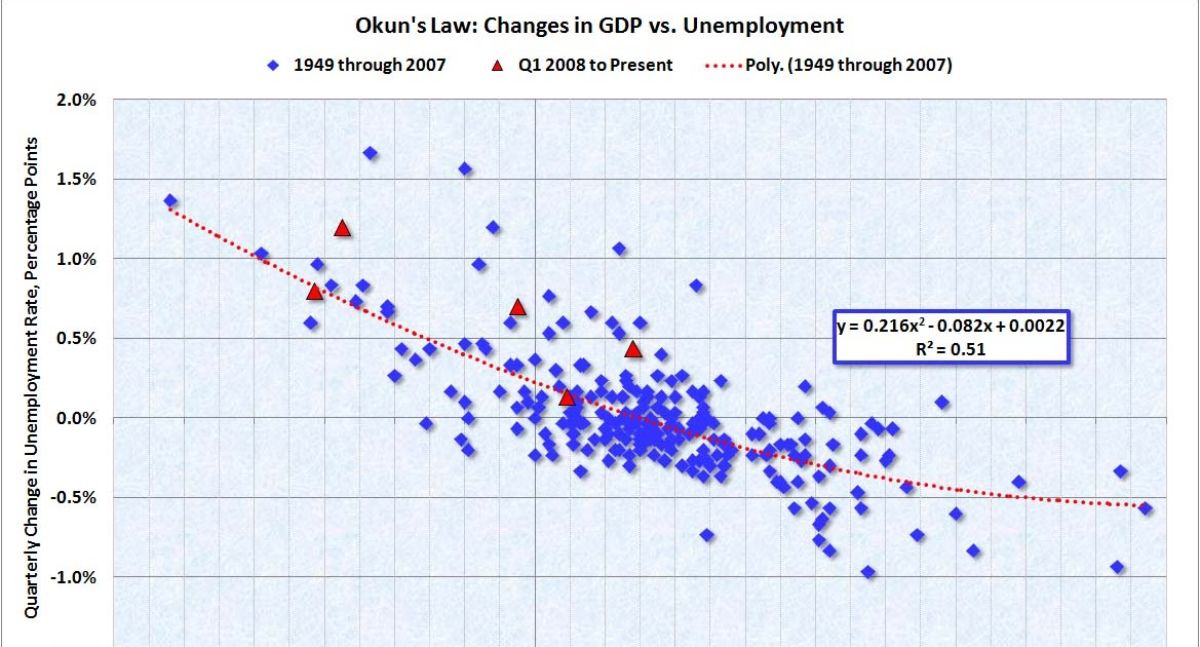
Have you ever heard of the Read Ley? In case you don't know, this dates from 1982 and the architect of this was Arthur Okun, an American economist who demonstrated an inverse correlation between the growth rate of the economy and the unemployment rate.
But is there more to know about this law? The truth is that it does, so we encourage you to keep reading and discover a law that explains many things related to the economy and unemployment or job creation.
What is Okun's Law

Okun's Law is a concept that was defined in the 60s by the American economist Arthur Okun. This found a relationship between the unemployment rate and the production of a country. This came out published in an article, the "Potential GNP: Its Measurement and Significance."
In it, Okun stated that, if employment levels were to be maintained, the economy had to grow between 2,6 and 3% annually. If it was not achieved, that was only going to increase unemployment. In addition, it established that, if a country managed to maintain that 3% of economic growth, unemployment would remain stable, but to reduce it, it was necessary to grow two percentage points for each one of unemployment that wanted to reduce.
What you may not know is that this "law" is impossible to prove. The economist used data from 1950 and only in the United States, and formulated this theory applying it only to an unemployment rate between 3 and 7,5%. Despite this, the truth is that the rules that Arthur Okun gave have been correct, and that is why it is still used in many countries.
In other words, Okun's law tells us that if a country's economy grows it will mean that more workers have to be recruited since a greater workforce will be needed. This will affect unemployment, reducing it. And on the contrary; if there is a crisis in the economy, then fewer workers will be needed, which will increase unemployment.
What is the formula of Okun's law
La Okun's law formula is this:
? Y / Y = k - c? U
This is impossible to understand, but if we tell you what each value implies, we will find:
- Y: is the variation of production in the economy. In other words, the difference between natural GDP and real GDP.
- Y: is the real GDP.
- k: it is an annual percentage of production growth.
- c: factor that relates the change in unemployment with the variations in production.
- u: change in the unemployment rate. That is, the difference between the real unemployment rate and the natural rate.
What is Okun's law for?

Despite what we have discussed before, the truth is that Okun's law is a very valuable tool. And it is that it allows predicting trends between real GDP and unemployment. What's more, it is used to evaluate what the unemployment costs will be.
Now, although we say that it is very valuable, the truth is that the data obtained, compared to the numbers in the real world, are incorrect. Why? Experts attribute this to the so-called "Okun coefficient."
One of the problems with this law is that when the rates are long term, the results are distorted and erroneous (that is why the short term can have a higher accuracy rate).
So is it good or bad? Does it really serve its purpose? The truth is that yes, but with nuances. Only when looking to analyze short-term trends between real GDP and unemployment are the data acceptable and used by analysts. However, if it is long-term, things change.
Why it behaves differently between countries

Imagine two countries with the same data. It is normal to think that, if you apply Okun's law formula, the results will be the same. But what if we tell you not to?
The Countries, despite having the same data and institutional frameworks, have differences. And that's because of the following:
Unemployment benefits
Imagine that when you are looking for work, you are offered unemployment benefit. That money may be small, but it can also be large, causing people to "get used to" receiving money for doing nothing and will ultimately look for less work.
Temporality
This does not refer in itself to the time, but to the temporality of the contracts. When many temporary contracts are made, beginning and ending, the only thing that is caused is that there are remarkable figures when it comes to destroying and creating.
And it will affect the formula, especially in GDP and the unemployment rate.
Labor laws
There is no doubt that laws are a double-edged sword. On the one hand, they help protect workers. But they also cause the unemployment rate to enter an economic cycle. That firing costs, if they are low, makes companies hire more people unceremoniously, for specific tasks.
External demand
According to Okun's law, When the economy of a country depends on the foreign sector, it tends to have fewer problems than unemployment decreases.
Problems in productivity and diversification
Imagine that efforts are directed to a single task. Now, instead of one, you have 10. In which situation are you going to feel most productive? The most normal thing is that if you only dedicate yourself to one thing, you specialize in it. But if there are more, things change.
It is clear that the Okun's law is a good tool for economics and macroeconomics. But it must be taken with a grain of salt since the results are not always real, both in the short and long term. That is why we must take into consideration other types of factors that can influence. Did you know this law before? Is there any doubt that has not been clear to you?